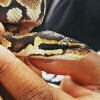» Site Navigation

0 members and 761 guests
No Members online
Most users ever online was 47,180, 07-16-2025 at 05:30 PM.
» Today's Birthdays

» Stats

Members: 75,944
Threads: 249,136
Posts: 2,572,316
Top Poster: JLC (31,651)
|
-
Registered User


Handling My Guy: Am I Reading Him Correctly?
I am working on handling my boy a couple days a week, between feedings. Thus far, I make sure to move slowly around him and try to read him as best as I can for signs of stress. Generally, a handling progression looks like this:
1. I take him out and hold him on my hand
2. He sits there for a while, not balled up tightly; just kind of resting/watching. He kind of side-eyes me, staying very still and making sure he's in a safe place.
3. He starts to poke out his little tongue, getting curious. (I was actually able to put my finger near his chin today without the freeze-and-look response, and have my smartphone pretty close to him without him startling)
4. He'll crawl along my arms and whatnot, fairly chill
5. Eventually, he'll get to the point where he's more active, but his startle response is a little more likely to occur despite moving slowly. After one or two startles, I'll put him back in his enclosure so he can calm down.
I'm assuming that number five is a stress response for sure. Is this correct? Are there any other places that I should be looking out for signs of stress? Are there any tips that anyone might have for getting him less head-shy? I feel like he's doing pretty well so far. He's only about two-and-a-half months old.
Thanks in advance! 
-
-
Ball pythons are naturally headshy, it's not really something that goes away. He's also a baby and they are more defensive and jumpy, so that may be why he's getting startled even when you move slowly. When he gets older and bigger, hell be more confident and won't startle as much.
Don't put him back right away when he flinches back/startles, let him calm down and handle him more. This will show him that you aren't going to hurt him and if you just put him back everytime he flinches he's going to think 'ok if i do this I'll get left alone'.
How long do you have him out for ??
1.0- Pastel het Pied- Khaa
-
-
Registered User


Re: Handling My Guy: Am I Reading Him Correctly?
 Originally Posted by PythonBabes

Ball pythons are naturally headshy, it's not really something that goes away. He's also a baby and they are more defensive and jumpy, so that may be why he's getting startled even when you move slowly. When he gets older and bigger, hell be more confident and won't startle as much.
Don't put him back right away when he flinches back/startles, let him calm down and handle him more. This will show him that you aren't going to hurt him and if you just put him back everytime he flinches he's going to think 'ok if i do this I'll get left alone'.
How long do you have him out for ??
Usually he lasts about fifteen to twenty minutes before he starts giving off the super-excitable vibes. I feel like he is considerably less afraid of smartphones, so there's that! 
-
-
I usually sort of let my snake tell me when he's ready to go back in his enclosure. Usually that's when he just stops exploring and curls up somewhere is when I put him back. That can be either 5 minutes or 2 hours haha. For babies I'd say 20 minutes out is good, but remember not to handle too much because that will stress them out.
1.0- Pastel het Pied- Khaa
-
-
If you have a general idea of when he gets to #5, I think ideally you want to put him back before that while he's still reasonably calm. Keep an eye on how fast he's breathing - faster breathing probably means he's nervous, even if he's holding still. For lots of prey species that rely on camouflage to avoid getting eaten, holding really still can be a defense/panic response, so that makes it harder to tell whether he's freaked out.
You want to reinforce the idea that you aren't scary and being out of the cage is OK. If he stays out until he's really panicking every time, and you put him back when he's panicking, it reinforces the association of panic with handling. He won't necessarily put together the pieces to figure out that you aren't going to eat him; his little brain will interpret the incident as a close escape from something scary and that won't help him be less scared next time.
If possible, you might also try to avoid grabbing him while he's asleep and instead take him out when he's already in an exploratory mood. If he's out and about and you open the cage, he might even venture out on his own.
-
The Following 2 Users Say Thank You to Coluber42 For This Useful Post:
EzraBlade (11-16-2017),Godzilla78 (09-17-2017)
 Posting Permissions
Posting Permissions
- You may not post new threads
- You may not post replies
- You may not post attachments
- You may not edit your posts
-
Forum Rules
|









 Reply With Quote
Reply With Quote

